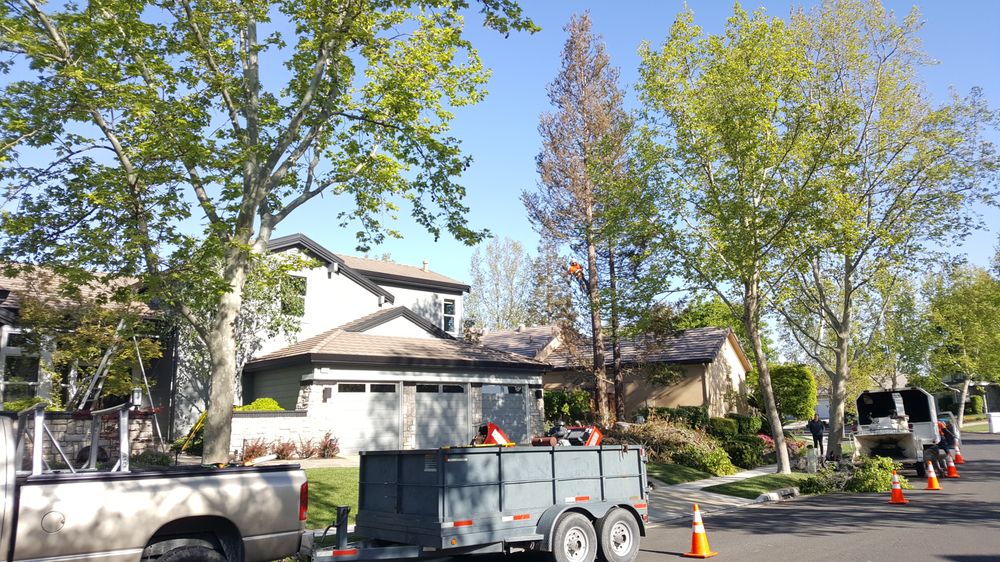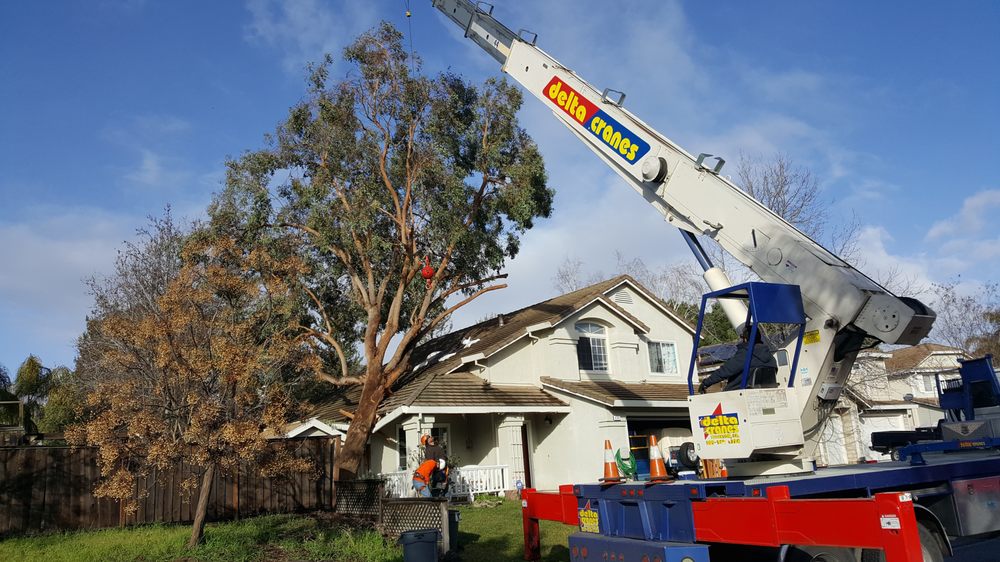Did you know that proper tree pruning can increase a property’s value by up to 20%? When it comes to maintaining California homes, choosing the best tree pruning techniques is crucial. In this ultimate comparison, we’ll explore the top methods for keeping your trees healthy and enhancing your outdoor space. From strategic timing to precise cuts, we’ll break down the most effective approaches for California’s unique climate and landscape. Whether you’re a seasoned gardener or just starting, these insights will help you make informed decisions and elevate your home’s curb appeal.

Pruning vs Trimming Trees
Purposeful Pruning
Pruning focuses on strategic cutting to enhance tree health, structure, and aesthetics. It involves removing specific branches to promote growth and address issues like disease or damage.
Pruning is ideal for young trees to establish a strong framework and encourage proper growth patterns. By selectively removing branches, the tree’s overall health and appearance can be significantly improved.
Precision Trimming
Trimming, on the other hand, involves cosmetic cutting to maintain a tree’s shape and size. It is more about maintaining the existing form rather than influencing future growth.
Trimming primarily targets overgrown branches, stray limbs, or excessive foliage to enhance the tree’s appearance without altering its fundamental structure.
Impact on Tree Health
Pruning, with its targeted approach, plays a crucial role in improving a tree’s overall well-being. By eliminating dead or diseased branches, it prevents further decay and promotes healthy growth.
Trimming, while beneficial for aesthetics, may sometimes lead to stress for the tree if done excessively. Over-trimming can weaken the tree by reducing its ability to photosynthesize effectively.
Aesthetics vs Structural Integrity
When deciding between pruning and trimming, consider whether your priority lies in enhancing the tree’s appearance or ensuring its long-term structural integrity.
Pruning is preferred when addressing structural issues like weak branches or promoting new growth directions. It helps maintain a tree’s health and longevity by fostering proper development.
Trimming, on the other hand, is more suitable for maintaining a neat appearance without significantly impacting the tree’s internal structure. It is an excellent choice for trees that are primarily grown for ornamental purposes.
Benefits of Tree Pruning
Growth Enhancement
Proper tree pruning can significantly enhance the growth of trees by promoting new and healthy branches. This process eliminates dead or diseased branches, allowing the tree to allocate resources more efficiently for growth.
Pruning also encourages the development of a strong tree structure, reducing the risk of branches breaking during storms or heavy winds. Trees that are regularly pruned tend to grow taller and have a more balanced canopy, enhancing their overall appearance.
Appearance Improvement
One of the key benefits of tree pruning is improving the aesthetic appeal of trees in California homes. By removing overgrown or unsightly branches, pruning helps maintain a neat and well-manicured look for your landscape.
Pruning also allows for better sunlight penetration and air circulation within the tree, which is essential for overall tree health. This improved airflow reduces the risk of fungal diseases and promotes vibrant foliage throughout the year.
Health Maintenance
Regular tree pruning plays a crucial role in maintaining the health and vigor of trees in California. By removing dead or decaying branches, pruning prevents the spread of diseases and pests within the tree. It also helps identify early signs of infestation or infection, allowing for timely intervention.
Proper pruning techniques can also help rejuvenate older trees by stimulating new growth, leading to increased fruit production in fruit-bearing trees. Pruning promotes better nutrient absorption and water distribution throughout the tree, supporting its long-term health.
Dead Branch Removal Techniques
Effective Methods
Dead branches on trees can be safely removed using various techniques. One method is pruning back to the collar, which involves cutting the branch close to the trunk without damaging the branch bark ridge. Another effective technique is using a pruning saw to make clean cuts that promote quicker healing for the tree.
Significance of Removal
Eliminating dead branches is crucial for both the health and safety of trees. These branches can attract pests and diseases, leading to potential harm to the tree. By removing them, you prevent further decay and protect the overall well-being of the tree.
Impact on Tree Aesthetics and Growth
The removal of dead branches not only enhances the appearance of trees but also promotes healthy growth. It allows for better air circulation and sunlight penetration, encouraging new growth in lateral branches. This process results in a more aesthetically pleasing tree with improved structural integrity.
Enhancing Tree Light and Airflow
Sun Exposure
Proper pruning helps trees receive adequate sunlight, crucial for photosynthesis and overall health. Trim branches blocking the sun to promote growth.
Maintaining optimal sun exposure prevents issues like weak growth and sparse foliage. It also reduces the risk of diseases caused by insufficient sunlight.
Improving Air Circulation
Enhance air circulation within trees by strategically removing crowded branches. This promotes better health by reducing moisture, preventing fungal growth.
Pruning for airflow also decreases the chances of pests infesting the tree, ensuring a thriving and healthy environment for your landscape.
Avoiding Power Lines
When pruning for light and airflow, consider nearby power
to prevent accidents. Trim branches that could potentially interfere with electrical wires.
Regularly inspect trees close to power lines to ensure safety and compliance with regulations. Proper maintenance can prevent hazardous situations.
Boosting Fruit and Flower Production
Enhancing Fruit Quality
Pruning techniques play a crucial role in enhancing fruit quality by promoting the growth of flower buds and ensuring proper distribution of nutrients. By trimming excess branches, trees can focus their energy on producing high-quality fruits.
Pruning also helps in raising the overall health of the plant by encouraging healthy growth. Removing water sprouts and dormant season shoots redirects the tree’s resources towards productive areas, leading to improved vigor.
Maximizing Flower Abundance
When done correctly, pruning contributes to maximizing flower abundance in flowering trees. By strategically cutting back branches during the spring, you stimulate the growth of new shoots that will eventually bloom into beautiful flowers.
Proper pruning techniques involve selective removal of old wood to make room for new growth, allowing for an increased number of flowers. This process not only enhances the aesthetic appeal but also ensures a continuous cycle of blooming throughout the season.
Increasing Fruit Yields
One of the primary benefits of employing effective pruning techniques is the significant increase in fruit yields. By removing excess branches and shaping the tree properly, you promote vegetative growth that supports a higher production of fruits.
Pruning during the dormant season helps in reducing overcrowding within the canopy, allowing sunlight to reach all parts of the tree evenly. This exposure to light stimulates fruit development and improves overall fruit size and quality.
Ensuring Proper Tree Clearance
Branch Pruning
Pruning large trees is essential to maintain a safe distance from structures and prevent damage. Regular tree pruning every few years ensures healthy growth and minimizes risks of falling branches.
Prune branches that overhang roofs or power lines to prevent accidents and property damage. Remove dead or diseased branches promptly to promote tree health and longevity.
Crown Thinning
Mature trees benefit from crown thinning to reduce wind resistance and stress on branches. This technique involves selectively removing branches to allow sunlight penetration and airflow within the canopy.
Thin out crowded areas in the tree’s crown to improve overall structure and reduce the risk of branch failure. Proper crown thinning promotes new growth, enhancing the tree’s aesthetic appeal.
Hazard Assessment
Regularly inspect trees for signs of decay, disease, or structural issues that may pose a risk. Identify potential hazards such as weak unions, cracks, or cavities that compromise tree stability.
Consult with a certified arborist for professional tree maintenance advice and hazard assessment. Addressing hazards promptly through proper pruning techniques can prevent accidents and property damage.

Step-by-Step Pruning Guide
Proper Timing
Pruning should be done seasonally to promote healthy growth and minimize stress on trees. Ensure you prune during the back part of the season to avoid new growth before winter.
Prune deciduous trees in late winter or early spring before new growth appears. For evergreen trees, late winter is also ideal, but be cautious not to prune during periods of extreme cold.
Essential Tools
Before starting, gather the necessary tools for effective pruning. These include pruning shears, loppers for thicker branches, a pruning saw for larger limbs, and protective gear such as gloves and safety glasses.
Correct Techniques
Begin by removing dead or diseased branches with clean cuts close to the trunk or parent branch to prevent tearing. Cutting at an angle just outside the branch collar helps with healing and prevents disease entry.
When pruning, follow the natural shape of the tree and avoid cutting too close or leaving stubs. Use proper techniques like thinning cuts to improve sunlight penetration and air circulation within the canopy.
Branch Size Matters
For smaller branches, use pruning shears for precise cuts without damaging surrounding tissue. Larger branches require loppers or a pruning saw for clean cuts that don’t tear or splinter the bark.
Remember not to remove more than 25% of a tree’s canopy in a single season to avoid excessive stress. Over-pruning can weaken the tree and lead to issues with growth and stability.
Final Touches
After pruning, inspect the tree for any signs of damage or potential issues that may require further attention. Applying a sealant to large wounds is unnecessary; instead, let the tree naturally compartmentalize the wound.
Ensure proper disposal of pruned branches and debris to prevent the spread of pests and diseases. Consider composting organic materials or arranging for professional disposal services.
Essential Pruning Tools
Hand Shears
Hand shears are essential for precise cuts on small branches and delicate plants, ensuring a clean pruning process. They are perfect for trimming hedges and shaping shrubs with accuracy.
Choosing the right hand shears depends on the branch size and effort required. Ensure they are sharp to prevent tearing the plant tissue, promoting faster healing after pruning.
Lopping Shears
Lopping shears are ideal for cutting branches with a diameter larger than 1 inch. Their long handles provide extra leverage, making it easier to prune hard-to-reach areas effectively.
When using lopping shears, make sure to position them correctly before making the cut to avoid damaging the tree’s bark or causing unnecessary stress.
Pruning Saws
Pruning saws are designed for cutting thick branches that hand shears or lopping shears cannot handle. They come in various sizes and tooth configurations, suitable for different types of wood.
Before using a pruning saw, identify the branch collar and make a proper cut just outside this area to promote quicker healing and reduce the risk of infection.
Choosing the Right Tools
When selecting pruning tools, consider factors such as branch size, branch angle, and tree species. Match the tool to the task; for instance, use hand shears for precision pruning and lopping shears for thicker branches.
Ensure all tools are sharp and well-maintained to prevent damage to the plant tissue and ensure clean cuts that aid in faster recovery. Regularly clean and oil your tools to prolong their lifespan and efficiency.
Safety Tips for Pruning
Climbing Safety
When climbing trees for pruning, always wear a safety harness and sturdy shoes to prevent falls. Use a reliable ladder with proper footing.
To ensure safety while climbing, inspect the ladder for any damages or defects before use. Secure the ladder at the base to prevent slipping accidents.
Tool Handling Precautions
When handling pruning tools, wear protective gloves and goggles to shield yourself from potential injuries. Ensure tools are sharp for clean cuts.
Inspect tools before each use, looking for any signs of wear or damage. Properly store tools in a secure location after pruning activities.
Importance of Safety Measures
Prioritize safety measures to avoid accidents during tree pruning activities. Accidents can result in serious injuries or even fatalities.
Closing Thoughts
You’ve now mastered the art of tree pruning, understanding the critical differences between pruning and trimming, the benefits it brings to your trees, and the various techniques involved. By following safety tips, using essential tools, and following a step-by-step guide, you can ensure your trees thrive. Enhancing light and airflow, boosting fruit production, and maintaining proper clearance are all within your reach now.
Take action today and apply these techniques to your trees. Not only will they look healthier and more vibrant, but they’ll also contribute to a safer and more beautiful outdoor space for you to enjoy. Your efforts in tree pruning will undoubtedly pay off in the long run. Keep up the good work!
Transform Your Landscape with JC Tree Service’s Precision Tree Pruning
If you’re facing tree-related challenges at your home or business, JC Tree Service is here to provide you with expert solutions. Whether it’s unsightly branches diminishing your property’s curb appeal or potential hazards threatening your safety, our specialized team handles it all. From precise tree pruning to comprehensive removal and landscaping services, we’ve got you covered in Brentwood, Antioch, and beyond.
Understanding the importance of both aesthetics and safety, we prioritize delivering top-tier tree care tailored to your needs. Tree pruning, in particular, is not just about enhancing visual appeal—it’s crucial for maintaining the health of your trees. It can prevent the spread of disease and minimize the risk of falling branches. With JC Tree Service, you can rest assured that your landscape is in professional hands. We are committed to keeping your outdoor spaces both beautiful and safe.
Don’t let tree problems overshadow the beauty and safety of your environment. Contact JC Tree Service today to discuss how our tree pruning and other services can transform your property. We offer a free, no-obligation quote to get you started. Experience the difference professional tree care can make!
Disclaimer
The materials available on this website are for informational and entertainment purposes only and not to provide legal or professional advice. You should contact your attorney or home improvement specialist to obtain advice concerning any particular issue or problem. You should not act or refrain from acting based on any content included in this site without seeking legal or other professional advice. The information presented on this website may not reflect the most current home improvement developments. No action should be taken in reliance on the information on this website. We disclaim all liability concerning actions taken or not taken based on any or all of the contents of this site to the fullest extent permitted by law.


